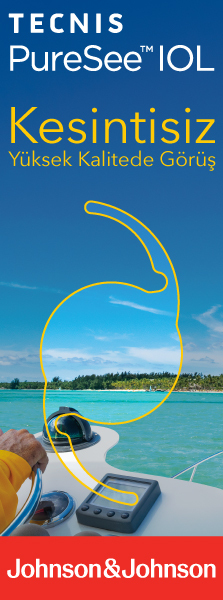TJ-CEO
2008 , Vol 3 , Num 2
Steroid-Induced Intraocular Pressure Elevation After LASEK
1Atatürk Eğitim ve Araştırma Hast. 1. Göz Hastalıkları Kliniği, Ankara, Uzm. Dr.2Numune Eğitim ve Araştırma Hast. 3. Göz Hastalıkları Kliniği, Ankara, Asist. Dr.
3Atatürk Eğitim ve Araştırma Hast. 1. Göz Hastalıkları Kliniği, Ankara, Prof. Dr. Purpose: To investigate the frequency of steroid-induced intraocular pressure elevation after laser-assisted subepithelial keratectomy (LASEK) for myopia.
Materials and Methods: This retrospective study included 65 eyes of 37 consecutive patients who were treated with LASEK for myopia. All patients underwent slit-lamp biomicroscopy, fundus and optic disc examinations, subjective and cycloplegic refractions, uncorrected visual acuity (UCVA), best corrected visual acuity, and pachymetry preoperatively and postoperatively at 21 days, and 1 and 3 months. Dexamethasone 1% was used topically for 2 months. Postoperative IOP values were corrected by a correction formula involving corneal ablation and keratometric change. Preoperative IOP, postoperative IOP, and corrected postoperative IOP measurements were analyzed.
Results: The patient cohort comprised 15 men and 22 women. Patients with 5 mmHg or more difference between corrected postoperative IOP and preoperative IOP were regarded as steroid responders. Steroid responsiveness was diagnosed in 27 eyes (27/65, 41.5%). Patients with 22 mmHg or more corrected postoperative IOP were regarded as having steroid-induced ocular hypertension (SIOH). SIOH was diagnosed in 15 eyes (15/65, 23.0%). Mean preoperative IOP was 13.5±2.5 mmHg (min 9 mmHg and max 19 mmHg) and mean postoperative IOP was 15.1±6.9 mmHg (min 8 mmHg, max 40 mmHg). There was no significant difference between mean preoperative IOP and postoperative IOP (p=0.104). Mean corrected postoperative IOP was 19.7±6.9 mmHg and the difference between mean preoperative IOP and corrected postoperative IOP was significant (p=0.001).
Conclusions: Due to the high frequency of steroid-induced intraocular pressure elevation, corrected IOP levels must be closely monitored after LASEK procedures. Keywords : LASEK, steroid-induced ocular hypertension, intraocular pressure





